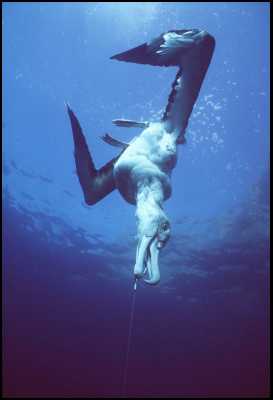Albatross Protection One Step Closer
WWF hopes New Zealand’s signing of the Agreement on the Conservation of Albatrosses and Petrels (ACAP) in Canberra today heralds a stronger stance on seabird protection by the government.
New Zealand is the albatross capital of the world – 13 out of a total 24 albatross species breed in our waters, and almost all of those are vulnerable or endangered (IUCN ranking).
“Long line fisheries are widely believed to be the major cause of falling albatross populations”, explained WWF New Zealand’s chief executive, Jo Breese.
“At the moment, the government is doing little more than research into albatross decline. WWF believes the steady drop in many albatross populations warrants stronger action.”
“Importantly, the ACAP urges governments to take the ‘precautionary approach’ – which means not waiting for further research before acting to protect albatrosses and petrels.”
“We urge the government to strengthen its national plan of action to at least include simple mitigation measures such as requiring boats to set at night, and to discharge ship’s waste away from setting and hauling”, said Jo Breese. “We also support the government’s move to place more observers on fishing boats.”
“New Zealand is fortunate to be home to so many albatrosses, we need to take a lead in protecting them.”

Image by Graham Robertson, Australia Antarctic Division
ENDS
Background:
- The Agreement on
the Conservation of Albatrosses and Petrels has been two
years in the making, including consultation between Southern
Ocean governments, governments of major fisheries nations,
NGOs, and the United Nations. It is hoped that all the
governments of major fisheries nations will sign it.
- In
the Southern Ocean, tuna fleets alone set more than 200
million hooks annually. There are similar sized fleets in
other fisheries as well.
- New Zealand-based albatross
species which are especially at risk of bycatch are:
White-capped, buller’s and Salvin’s albatrosses.
- Some
of the main longline fisheries in which seabird bycatch
occurs are: Patagonian toothfish, tuna, and ling.
- The
oldest albatross in the world, aged 66, is still alive.
-
The Wandering albatross has a wingspan of 3.5 metres, making
it the largest flying bird in the world.
- Albatrosses
have the highest proportion of threatened species of any
bird family, making them the most imperiled of all the
world’s seabirds.
Ends


 Gordon Campbell: On Why We Can’t Survive Two More Years Of This
Gordon Campbell: On Why We Can’t Survive Two More Years Of This Interchurch Bioethics Council: Church Bioethics Agencies Express Dismay at the Rushed Consultation Period for Submissions on the Gene Technology Bill
Interchurch Bioethics Council: Church Bioethics Agencies Express Dismay at the Rushed Consultation Period for Submissions on the Gene Technology Bill New Zealand Police: More Than $2.5m Worth Of Assets Restrained In Undeclared Tobacco Case
New Zealand Police: More Than $2.5m Worth Of Assets Restrained In Undeclared Tobacco Case SPCA: Survey Shows Government Lacks Mandate To Repeal Live Export Ban
SPCA: Survey Shows Government Lacks Mandate To Repeal Live Export Ban Peace Action Ōtautahi: Bridge Of Remembrance Peace Protest
Peace Action Ōtautahi: Bridge Of Remembrance Peace Protest National Wetland Trust: Public Asked To Help Prevent Fires In Wetlands This Summer
National Wetland Trust: Public Asked To Help Prevent Fires In Wetlands This Summer Lillian Hanly, RNZ: The Year In Politics - Stories That Dominated The Headlines In 2024
Lillian Hanly, RNZ: The Year In Politics - Stories That Dominated The Headlines In 2024


